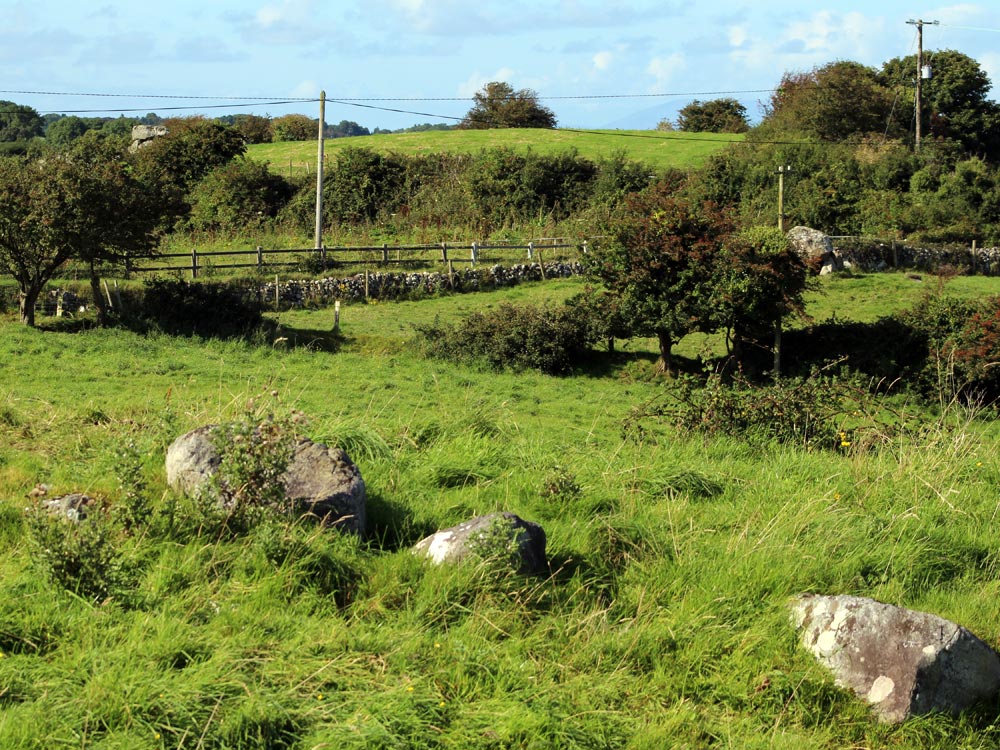These three monuments are badly damaged neolithic passage-graves on the east side of Carrowmore. The damage to the monuments was caused by a combination of road building, field clearance, and gravel quarrying. The Kilmackeown road runs right past the three monuments.
Circle 14
Only two gneiss boulders, partly buried remain of this monument. It was destroyed before 1837 when Petrie made his record. He got his information from Roger Walker, the local landlord who was a part-time treasure hunter who dug into many of the monuments.
Borlase: - No. 14.
Situated to the south of twenty, at the corner of the road (dolmen-circle).
"A few stones only remain. The rest, including the cromleac, have been displaced or removed by raising gravel."
- Petrie.
"Only two stones half buried in a pit are now visible."
- Wood-Martin.

Circle 15
Circle 15 is just past Circle 14, on the same side if the road. Fifteen boulders formed a circle eleven meters in diameter, and there is a smaller inner circle eight meters in diameter. Wood-Martin's report is given below. He found 1 kg cremated bone, antler pins, fragments of shells, a flake of flint and some pieces of quartz.
No. 15. Situated still more to the south, and on the east side of the road (dolmen-circle).
"This was a double circle, about forty feet in diameter, but a portion of the outer one has been destroyed to raise gravel—seventeen stones only remaining. The cromleac is ruined. Human bones were found within it by Roger Walker."
- Petrie.
On excavation, the interment was found to be greatly disturbed. No vestige, save one stone, of the cist or its flooring remained.
One of the first objects turned up was the bulbous portion of an instrument, almost the whole of which was afterwards discovered, formed of cetaceous bone, and nearly two feet long, which Colonel Wood-Martin regards as a sword or stabbing rapier. A fragment of a second, but much smaller, dagger-like instrument was also found, and three blackened portions of a third. It is to be compared with a shuttle of whalebone figured in Boyesen's "History of Norway," and Colonel Wood-Martin thought that it might have been formed from a bone of a dead Greenland whale, drifted ashore at Cuil Irra. The head of the larger instrument is like that of the fossilized bone one found in IV.
"There were also found," during this excavation by Colonel Wood-Martin, "a small fragment of flint, a diminutive white stone, a flake of fractured white quartz, a whitish-coloured egg-shaped stone, weighing 0.5 lb, fragments of shells of cockle, mussel, and of the genus Helix, 2 lbs. of calcined bones, two human incisors, one of which was still attached to the jaw, 3 ozs. of bones in an uncalcined state, which might be masses of the cancellous tissue of the head of the femur, or of the os innominatum, as also two (other) human incisors, one of them greatly worn at one side."
- Wood-Martin.
Circle 16
Only two of the stones from the boulder circle remain at this site. Another fourteen boulders can be seen nearby. The circle was eleven meters in diameter and had an inner circle. One stone from the chamber and a displaced roof stone are still on the site. Finds from Wood-Martin are listed below.
Borlase: - No. 16.
Situated immediately to the south of Twenty two, and adjoining the road (dolmen-circle).
"This is also a double circle, and about the same diameter (40 feet) as Twenty two; but the outer circle is nearly destroyed, and the covering of the cromleac is displaced. It (the table-stone) measures 13 feet in circumference, 4 feet 4 inches long, and 1 foot 6 inches thick.
- Petrie.
"Three small fragments of uncalcined bones, pieces of oyster-shell, and a flint flake, represented all that was discovered here."
- Wood-Martin.


